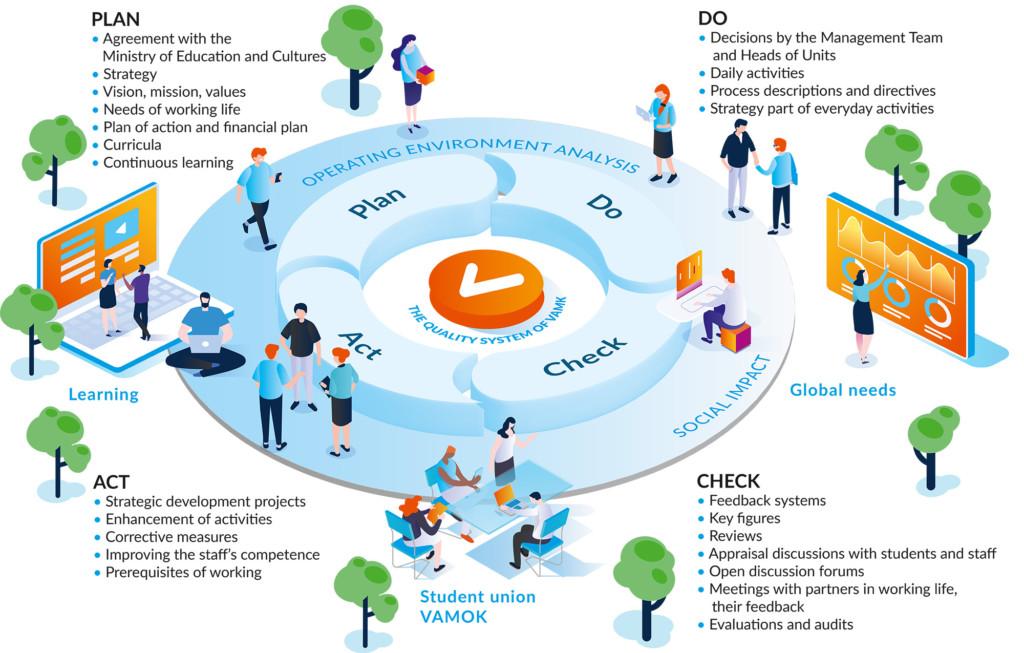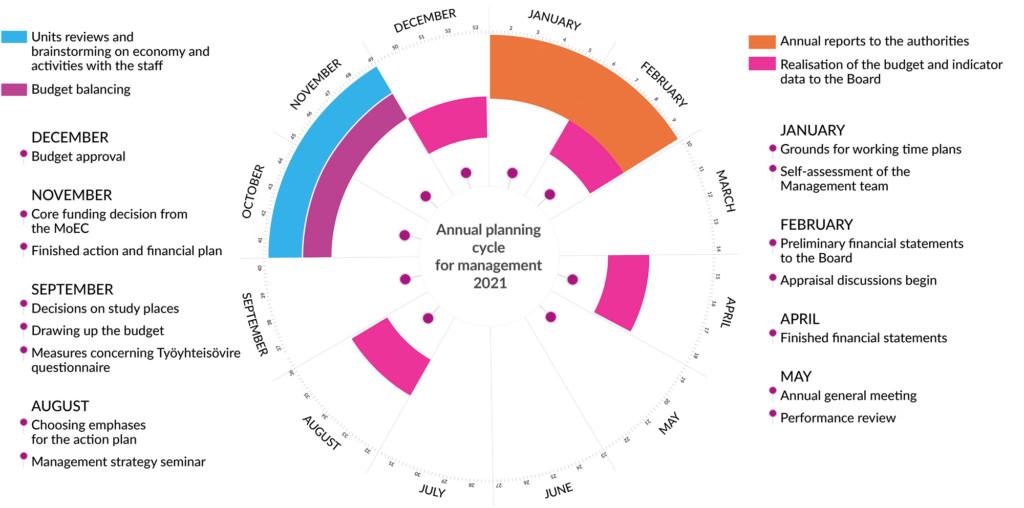Högskolans självvärdering

Figure 5. VAMK’s quality system
Strategic goals give a direction to activities
Our vision, mission and values highlight competence and its continuous enhancement. This applies to the competence of our students, cooperation partners as well as our staff and the development of VAMK as an organisation. Our strategy, published in the spring of 2020 and spanning to the year 2030, defines five targets, outlooks towards which we aim for through the enhancement areas connected with them. All five enhancement areas have been assigned main indicators with the Ministry of Education and Culture (henceforth MoEC), which make the achievement of the targets concrete. These indicators and related enhancement areas are listed in our Quality Handbook.
Quality System as a Tool for Management and Leadership
The quality system with related process descriptions, procedures in quality management, annual planning cycles, indicators and feedback systems is a tool for the management and leadership to attain the strategic goals. The budget and action plans drawn up in accordance with the instructions given by the Management Team are based on the agreement signed with the MoEC and previously mentioned enhancement areas. The goals of the previous year and their achievement are assessed in the unit reviews held in October-November, and the goals stated in the action plan of the unit and the enhancement areas for the following year are reviewed. The budget proposal is created based on the unit budget meetings during the autumn. The President takes the budget proposal to the Board to be approved.
The activities and results of the previous year are reviewed in May in supervisors’ performance review when the latest statistics, indicator data and feedback summaries from the previous year are available. The observations and assessments made in the performance review produce the foundation for the Management’s strategy seminar in which the assessments made in the performance review help in the decision-making of the enhancement areas, emphases and plans for staff training for the following year. To make the follow up of the activities systematic, annual planning cycles have been drawn up for both the Board and the Management Team, in which the most important tasks of the bodies have been written down. The responsibilities of actors in quality management are summarized in a table in quality policy. Figure 6. shows the most important tasks of the VAMK Management in an annual planning cycle for 2021.

Figure 6: Annual planning cycle for the Management
Quality System Managed by Knowledge
The Board and the Management Team follow up the achievement of the targets agreed with the MoEC using the indicators four times a year. We will present the achievement of the intermediate targets to the MoEC during their next visit in 2022. In addition to these, VAMK has its own indicators for the Board and the units. The Board supervises the development of financial affairs and the HEI’s main tasks, education and RDI activities. The regional characteristics are manifested by the fact that the Board aims to promote the employment of our international students in the region after their graduation. The Board and the Management Team inspect the indicators quarterly. The indicators for the units show the goals and the enhancement areas set as emphases, such as number of publications, Master’s degrees and strategic class A type cooperation agreements. The unit indicators are the ones the achievement of which the staff can contribute to with their own actions. The indicators that follow up the activities of the units are presented in the Quality Handbook in Figure 5.
Jointly Built Strategy
Compared to the previous strategy process, we have wanted our staff to have a more active role in the formulation of the strategy so that each team has had an opportunity to bring up their views on the matters important to them. This supports the commitment to the targets and helps our staff to see the significance of their own work to achieve the targets. The structure and the indicators have been modified to a more concrete form so that they serve better as tools for steering. At the beginning of the strategy work we used a joint dashboard where the participants could see and comment on the proposals made by others. In the autumn of 2020, the strategy process has continued to take the strategy into everyday work in workshops led by the directors and immediate supervisors. The indicators have been in use for a year now, and we will improve and develop them as need be, as the strategy implementation advances. The indicators followed by the Board and the Management Team quarterly will be built on a digital dashboard to facilitate the real-time follow-up.
| Strengths |
Enhancement areas |
|
Strategy, built together, which steers the activities
|
| Quality system managed by information |
|
|
Indicators that support various phases of quality system
|
Enhancement of knowledge production services |
|
Our staff’s educational plan supports the achievement of strategic goals
|
Active use of the budget and action plan in supervisors’ work |
VAMK’s quality policy is in line with the institutional strategy
VAMK’S quality policy outlines the guiding principles of the institutional quality work and thus fosters the implementation of VAMK’S strategy. The links between strategy, quality policy and quality management are laid down in VAMK’s Quality Handbook, which is published both in Finnish and English on the website of the institution. This handbook describes the functioning of VAMK’s Quality system, which is based on the cycle of continuous improvement (Plan – Do – Check – Act) as well as the responsibilities of the various actors in an appropriate way. Process descriptions, procedures, as well as directives complement the Quality Handbook for actual use and are available on the intranet.
VAMK’s strategy 2030 is well-known among the staff members, students, and key partner organisations. In the interviews, staff members confirmed that the strategy was developed in a dialogic and collaborative process, thus ensuring that all staff are aware of the connection between VAMK’s strategic goals, their own work, and their contribution to quality enhancement. External stakeholders also had an opportunity to contribute to VAMK’s strategy.
The quality system provides a sound basis for the management of the institution
VAMK’s quality system produces appropriate information especially for management needs. Strategic indicators help to monitor the objectives set for each of the strategic areas for enhancement and have been adapted to the needs of each user group such as the Heads of Units, the Management Team, and the Board of VAMK. Annual planning cycles for the board and the management are clearly designed and highly appreciated as was confirmed in the interviews. Furthermore, the interviews brought evidence that the Board is highly committed to quality work and actively monitors the achievement of goals through the respective indicators.
The Management Team systematically reviews the results produced by the quality system. This enables a large-scale development and reduces the risk that minor details prevail and endanger development activities. Strategic indicators are reviewed four times a year. At the time of the audit visit, the supervisors still had to manually extract indicator data for their areas of responsibility. However, the auditors learned that the data production and the reporting of indicators will soon be automated by means of a new dashboard. Thus, more time will be available for the qualitative analysis of information and results. The auditors welcome this development.
The strategic goals are implemented through the economic and action plans of the units and the entire institution. The action plans define the targets for each unit which relate to VAMK’s strategic goals and areas for enhancement. Monitoring of the action plans is based on information stemming from quality management and the use of the strategic indicators.
So far, VAMK has developed a fairly large number of quantitative indicators to measure the results of its strategic and quality work, yet none for societal engagement and impact. The audit team encourages VAMK to also develop indicators for this strategic area and to reconsider the strong emphasis of quantitative indicators. The auditors recommend finding a balance between quantitative and qualitative information, and also include qualitative indicators in their quality management toolbox.

